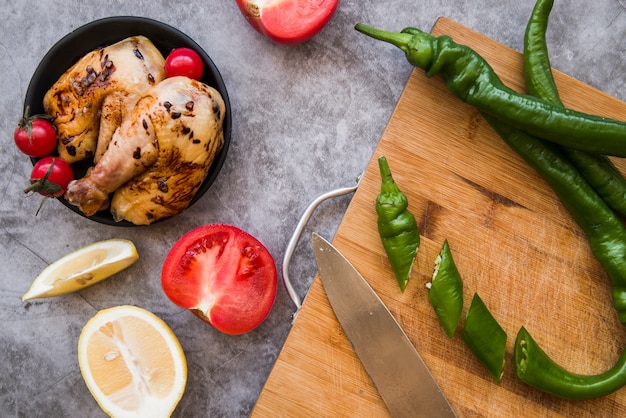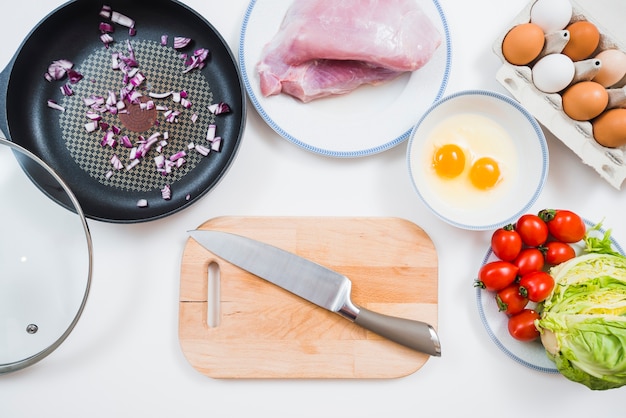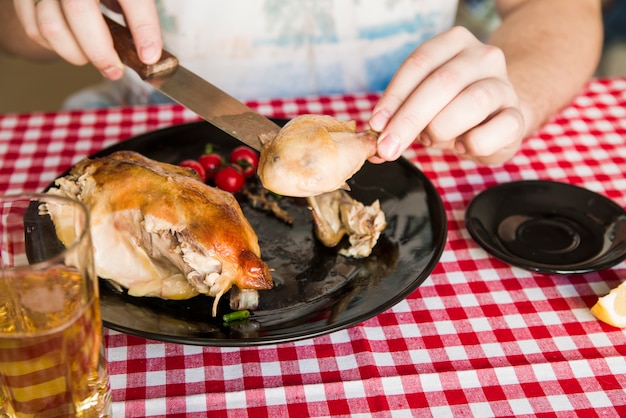Let's be honest, chicken hearts aren't exactly the most glamorous ingredient. They're often overlooked, relegated to the back of the butcher's counter or ignored altogether. But I'm here to tell you, don't dismiss them! These little bundles of flavor are a hidden culinary gem, and once you know how to cook them right, you'll be hooked.
My journey with chicken hearts started with a bit of curiosity and a lot of skepticism. The butcher at my local market insisted they were delicious, but I had my doubts. "They're like little nuggets of pure, concentrated chicken flavor," he declared, almost with a twinkle in his eye. I took the plunge, and I'm glad I did. Now, I'm a convert, and I'm eager to share the secrets of cooking chicken hearts with you.
This recipe is for anyone who's a little adventurous in the kitchen, anyone who's always on the lookout for something new and exciting. It's a simple, straightforward guide that will unlock the delicious potential of chicken hearts, leaving you wondering why you ever hesitated in the first place.
Part 1: Getting Started - Choosing Your Chicken Hearts

Finding the perfect chicken Hearts
The first step is, of course, acquiring your chicken hearts. Now, you might be wondering, where do I even find these? You have options! My go-to spot is the local butcher. They usually have fresher, less-processed chicken hearts than what you'll find at the supermarket. Plus, it's a great opportunity to chat with them and learn their tips on handling these unique ingredients.
If you're shopping at a supermarket, look for hearts that are firm and bright red in color. Avoid any that are bruised, discolored, or have a strange smell. You're looking for hearts that are fresh and ready to be transformed into a delicious meal.
Preparing the Chicken Hearts
Once you have your chicken hearts, it's time for a bit of prep work. This might seem like a chore, but it's essential for achieving the perfect texture and flavor.
- Give them a good rinse: Start by rinsing the hearts under cold water to remove any loose bits or debris.
- Remove the blood vessel: Now, here's the key step. You'll need to remove the large blood vessel attached to the tip of each heart. This part can be a bit chewy, and frankly, it's not the most appetizing. Grab a sharp knife, and with a little confidence, cut it off. You'll be left with a more tender and flavorful heart.
- Slice for even cooking: To ensure even cooking and make them easier to eat, slice the hearts in half lengthwise. You can even slice them into smaller pieces if you prefer. This helps the heat penetrate more evenly during cooking.
- Pat them dry: Finally, pat the hearts dry with a kitchen towel or paper towels. This helps prevent steaming, allowing them to brown beautifully during cooking.
Part 2: The Flavour Factor - Seasoning and Marinating

Basic Seasoning
You can keep things simple and just season the hearts with salt and pepper. A sprinkle of paprika adds a lovely bit of color and a warm, smoky note.
The Magic of Marinades
However, for a truly exceptional flavor experience, I highly recommend using a marinade. This is where things get exciting! Marinades not only tenderize the meat but also infuse it with a deep, complex flavor. Here are a few of my go-to marinade ideas, each with its own distinct character:
- Garlic and Herb: Combine olive oil with a generous amount of crushed garlic and fresh herbs like rosemary and thyme. A squeeze of lemon juice adds a bright, citrusy note. This marinade is perfect for those who enjoy a classic Mediterranean flavor profile.
- Honey and Soy: Mix honey, soy sauce, grated ginger, and a touch of sesame oil. This creates a sweet and savory marinade with an Asian twist. The honey adds a subtle sweetness, while the soy sauce and ginger provide a salty and earthy base. The sesame oil adds a nutty aroma and a touch of richness.
- Spicy: If you like a bit of heat, this marinade is for you. Combine chilli flakes, paprika, garlic, and your favorite hot sauce. Adjust the amount of chili to your personal spice tolerance. This marinade is ideal for those who like a little kick with their chicken hearts.
Tips for Marinating
- Time is your friend: Let the chicken hearts soak in the marinade for at least an hour. The longer you marinate them, the more flavor they will absorb. I often marinate them for several hours or even overnight for maximum flavor intensity.
- Keep it chilled: Store the marinated chicken hearts in the refrigerator, covered with cling film or in an airtight container. This prevents any unwanted odors from spreading in your fridge and ensures that the marinade stays fresh.
Part 3: cooking time - Bringing Out the Best

The Power of Pan-Frying
My preferred method for cooking chicken hearts is pan-frying. It creates a lovely crispy exterior while keeping the inside juicy and tender.
- Heat the oil: Heat a good amount of oil in a large skillet over medium heat. This will help ensure that the hearts cook evenly and develop a nice golden brown color. Don't be shy with the oil, but don't drown them either.
- Cook in a single layer: Add the chicken hearts to the hot pan, making sure to cook them in a single layer. Avoid overcrowding the pan, as this will lead to steaming rather than browning. You want the hearts to have ample space to cook evenly and develop a crispy texture.
- Cook until golden brown: Cook the hearts for about 3-5 minutes on each side, or until they are golden brown and cooked through. You can check for doneness by cutting a heart open and ensuring that the inside is no longer pink. If you have a meat thermometer, you can also ensure they reach an internal temperature of 165°F (74°C).
- Drain excess oil: Once the hearts are cooked, remove them from the pan and place them on a plate lined with paper towels. This helps absorb any excess oil, leaving you with a crispy, flavorful result.
Other Cooking Methods
While I love pan-frying, there are other ways to cook chicken hearts, each with its own unique qualities:
- Baking: Spread the hearts in a baking dish and bake in a preheated oven at 350°F (175°C) for 15-20 minutes, or until they are cooked through. This method is ideal for a hands-off approach and yields a tender result.
- Grilling: Thread the hearts onto skewers and grill over medium heat for 5-7 minutes, turning halfway through. This is a great option for outdoor cooking and results in a smoky flavor.
- Stir-frying: Add the hearts to your favorite stir-fry recipe towards the end of the cooking time. This allows them to cook quickly and absorb the flavors of the other ingredients. Remember to stir-fry them for a short time to ensure they remain tender and juicy.
Part 4: Finishing Touches - Adding Extra Zing
A Splash of Sauce
A simple sauce can really elevate the chicken hearts to another level. I often create a delicious pan sauce by using the leftover juices in the pan, a bit of butter, and some herbs like parsley or thyme. The flavors of the marinade, infused into the juices, create a truly delicious base for the sauce.
Get Creative with Toppings
Once you have your perfectly cooked chicken hearts, get creative with toppings!
- Chopped fresh herbs: A sprinkle of chopped fresh herbs like parsley, dill, or chives adds a burst of freshness and flavor. Choose herbs that complement the flavor profile of your marinade or sauce.
- Lemon wedges: A squeeze of lemon juice adds a bright, tangy contrast to the richness of the chicken hearts. The acidity of the lemon helps to cut through the richness and adds a refreshing element. This is a classic pairing that works beautifully.
- Toasted sesame seeds: These add a nutty flavor and a delightful crunch to the dish. Toast the sesame seeds in a dry skillet over medium heat until they are fragrant and lightly browned. This simple step enhances their flavor and texture.
- Crushed red pepper flakes: For those who like a little heat, a sprinkle of crushed red pepper flakes adds a fiery kick. Adjust the amount based on your preferred spice level.
Part 5: Serving Up - The Perfect Accompaniments
side dish Ideas
Chicken hearts can be the star of the show or a delightful addition to your side dish repertoire. Here are a few ideas for serving these flavorful little morsels:
- mashed potatoes: A classic comfort food that pairs beautifully with the richness of the chicken hearts. The creamy texture of mashed potatoes contrasts nicely with the crispy exterior of the hearts.
- Roasted vegetables: roast brussels sprouts, carrots, or sweet potatoes for a vibrant and healthy side dish. The roasted vegetables add a touch of sweetness and earthiness that complement the savory flavor of the chicken hearts.
- Green salad: A fresh and light green salad with a vinaigrette dressing adds a contrasting element and helps to cut through the richness of the chicken hearts. Choose vegetables that complement the flavors of your dish.
- Rice: A simple side of white or brown rice is a versatile option that works with any flavor profile. It provides a neutral backdrop that allows the chicken hearts to shine. You can even get creative with flavored rice, adding a bit of ginger, garlic, or herbs.
Part 6: A World of Flavours - Exploring Different Recipes
Chicken Hearts with a Mediterranean Twist
This recipe embraces the bright and fresh flavors of the Mediterranean region.
- Marinate: Mix olive oil, lemon juice, garlic, oregano, salt, and pepper. Marinate the chicken hearts in this mixture for at least an hour. The lemon juice adds a tangy brightness, while the garlic and oregano provide a savory depth. The olive oil helps to tenderize the hearts and create a rich flavor.
- Pan-fry: Pan-fry the marinated hearts until golden brown and cooked through. The pan-frying method allows for a crispy exterior while keeping the inside juicy.
- Serve: Serve the cooked hearts over a bed of couscous. Add chopped tomatoes, olives, and crumbled feta cheese for a complete Mediterranean experience. The couscous provides a light and fluffy base, while the tomatoes, olives, and feta cheese add a burst of flavor and texture.
Chicken Hearts with a Spicy Kick
This recipe packs a punch with the heat of chili flakes, ginger, and garlic. It's perfect for those who enjoy a bit of spice with their meals.
- Marinate: Combine soy sauce, honey, grated ginger, garlic, chili flakes, and sesame oil. Marinate the chicken hearts in this mixture. The soy sauce adds a salty and umami base, while the honey adds a touch of sweetness. The ginger and garlic create a warm and aromatic flavor, and the chili flakes provide a fiery kick. The sesame oil adds a nutty aroma and a touch of richness.
- Pan-fry: Pan-fry the marinated hearts until golden brown and cooked through. This method allows the hearts to develop a crispy exterior and retain their juicy interior.
- Serve: Serve the hearts over rice with a side of stir-fried vegetables. The rice provides a neutral backdrop for the spicy chicken hearts, and the stir-fried vegetables add a variety of textures and flavors. Choose vegetables that complement the flavors of the marinade, such as bell peppers, onions, broccoli, or snap peas.
Chicken Hearts with a Creamy Sauce
This recipe features a rich and creamy sauce that complements the savory flavor of chicken hearts perfectly.
- Pan-fry: Pan-fry the chicken hearts until cooked through. This step ensures that the hearts are cooked evenly and have a slightly crispy texture.
- Make a roux: In the same pan, melt butter and whisk in flour to make a roux. The roux will thicken the sauce and create a creamy base. Cook the roux for a few minutes over low heat, stirring constantly, until it is light brown in color. This step helps to develop a deeper flavor in the sauce.
- Add cream: Gradually whisk in heavy cream to the roux, cooking until the sauce thickens. Be sure to whisk constantly to prevent lumps from forming. Adjust the consistency of the sauce to your preference, adding more cream for a thinner sauce or less cream for a thicker sauce.
- Incorporate cheese: Stir in grated Parmesan cheese. The Parmesan adds a salty and umami flavor that complements the richness of the sauce. Use freshly grated Parmesan cheese for the best flavor and texture.
- Add herbs: Stir in herbs like parsley or thyme. These herbs add a fresh and aromatic flavor that enhances the overall taste of the dish. Choose herbs that complement the flavor profile of the dish.
- Serve: Pour the creamy sauce over the cooked chicken hearts and serve with pasta or mashed potatoes. The creamy sauce pairs beautifully with both pasta and mashed potatoes, providing a rich and satisfying meal.
Part 7: Chicken Hearts: A budget-friendly and Delicious Choice
Value for Money
Chicken hearts are a great value for money, often costing less than other cuts of chicken, such as breasts or thighs. It's a fantastic way to stretch your budget without sacrificing deliciousness.
Nutritional Benefits
Don't be fooled by their appearance! Chicken hearts are packed with nutrients. They are a good source of protein, iron, and other essential vitamins and minerals. They are a great addition to a balanced diet, offering a unique source of nutrition.
Part 8: FAQs - Addressing Your Chicken Heart Queries
FAQs
| Question | Answer |
|---|---|
| Can I freeze chicken hearts? | Yes, you can freeze chicken hearts for up to 3 months. Make sure to wrap them tightly in cling film or freezer-safe bags to prevent freezer burn. You can use them straight from the freezer, but for best results, defrost them in the refrigerator overnight before cooking. This helps to ensure even cooking and prevents the hearts from becoming tough. |
| What's the best way to tell if chicken hearts are cooked through? | The best way to tell if chicken hearts are cooked through is to cut one open and make sure the inside is no longer pink. You can also use a meat thermometer to ensure they reach an internal temperature of 165°F (74°C). This ensures that the chicken hearts are safe to eat and prevents any risk of foodborne illness. |
| Can I use chicken hearts in other dishes? | Yes, you can use chicken hearts in a variety of dishes, including stews, soups, and even pasta sauces. Just remember to cook them thoroughly before adding them to your dish. They add a unique texture and a concentrated flavor to these dishes. |
| What's the best way to store leftover chicken hearts? | Store leftover chicken hearts in an airtight container in the refrigerator for up to 3 days. You can reheat them in a pan or in the microwave. This helps to maintain their freshness and flavor. |
| Are chicken hearts good for you? | Chicken hearts are a good source of protein and iron, but they are also high in cholesterol. If you are concerned about your cholesterol levels, it is best to eat chicken hearts in moderation. As with any food, it's important to consume them as part of a balanced diet. |
Part 9: A culinary adventure Awaits
I hope you've enjoyed this deep dive into the world of chicken hearts. I've shared my experiences, tips, and tricks to encourage you to embrace this often overlooked ingredient. Give it a go! You might just discover a new favorite. Don't be afraid to experiment with different marinades, cooking methods, and side dishes. The possibilities are endless! Remember, cooking is an adventure, and with a little curiosity and a willingness to try new things, you can create truly delicious and satisfying meals.
Happy cooking!
Everyone is watching

Prime Rib Roast Cooking Time Chart: Per Pound Guide
Cooking TipsPrime rib roast. Just the name conjures images of lavish dinners, crackling fires, and hearty laughter. It’s ...

How Long to Bake Potatoes in the Oven (Perfect Every Time)
Cooking TipsBaked potatoes are a staple in my kitchen. They're incredibly versatile, delicious, and surprisingly easy to m...

Perfect Rice Every Time: The Ultimate Guide to Cooking Rice
Cooking TipsAs a self-proclaimed foodie, I've always been a bit obsessed with rice. It's the foundation of countless cuisi...

The Ultimate Guide to Cooking Asparagus: Tips, Techniques, and Recipes
Cooking TipsAsparagus. The mere mention of this spring delicacy conjures up images of vibrant green spears, crisp and burs...

Ultimate Guide to Cooking the Perfect Thanksgiving Turkey
Cooking TipsThanksgiving. Just the word conjures up images of overflowing tables laden with delicious food, the scent of r...
